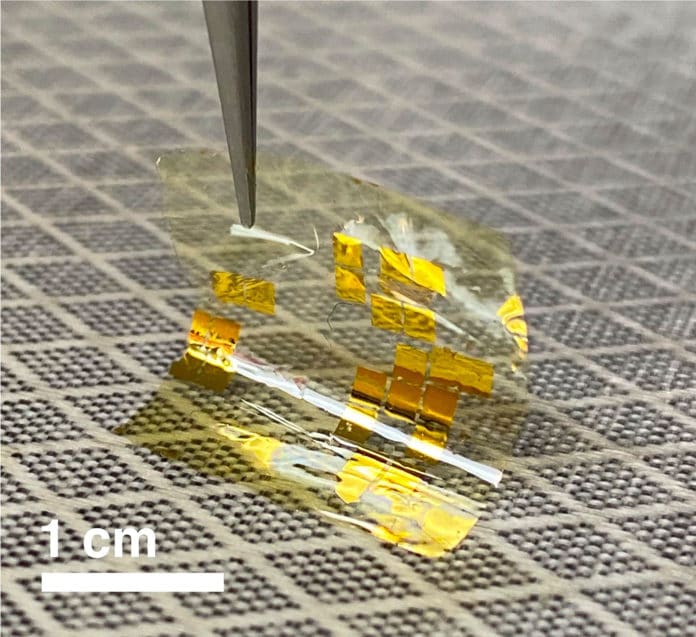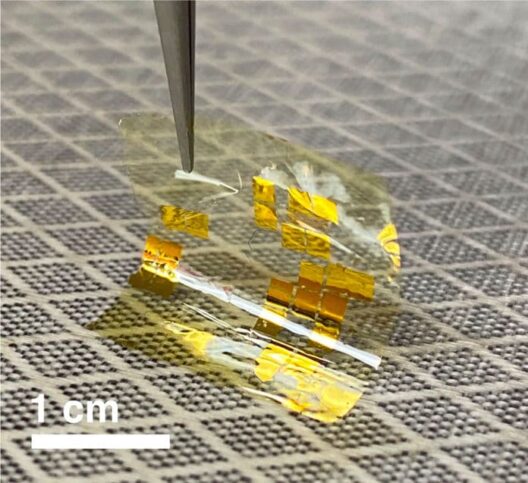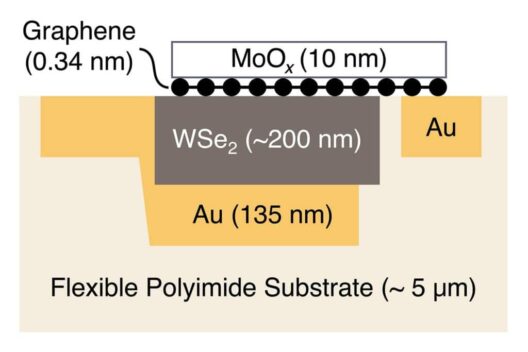We’ve noted here recently that early (and even current) examples of solar-powered aircraft suffered from the low efficiency of the panels that collected sunlight to power them. The panels add weight, and so far, nobody’s flying with more than 29-percent efficiency. What if a different approach, using ultra-thin solar cells covered the entire aircraft? That’s the possibility with Stanford University’s “new, ultrathin photovoltaic materials.”
Your Editor’s take on this is that 5.1-percent efficiency now offered by the Stanford solar cells could be applied by wrapping the entire plane, much like car customizers wrap high-end automobiles. That’s occurred to researchers. “Imagine an autonomous drone that powers itself with a solar array atop its wing that is 15 times thinner than a piece of paper,” said Koosha Nassiri Nazif, a doctoral scholar in electrical engineering at Stanford and co-lead author of a study. “That is the promise of TMDs.” TMDs refers to Transition Metal Dichalcogenides.
This material is composed of a so-called “transition metal,” named primarily for their position mid-point in the periodic table, and one of three chalcogenides, sulfur, selenium, or tellurium. These materials show great promise with extremely low weights for the sunlight they gather.
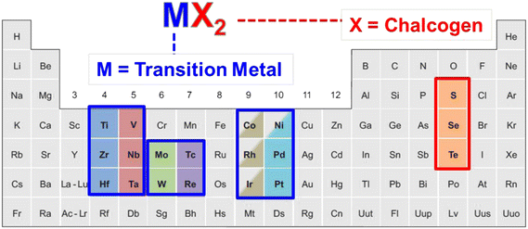
There are a number of possible layered structure TMDs. Materials consist of 16 transition metals and three chalcogen atoms. In the case of Co, Rh, Ir and Ni, only a few layered structures are observed…
Not only that, but their thinness and Saran™Wrap-like flexibility would enable wrapping them over even irregular surfaces. Most less-flexible solar cells occupy only the upper surfaces of wings or horizontal tails, limiting their ability to collect light from unlimited directions. Solar Impulse had to be able to store enough energy overnight and into the first few hours of the new day to begin recharging its batteries.
Think, then of the many aspects of flight. Aside from straight and level flight, with the sun at an appreciable angle above the craft, there is little opportunity for the sun to provide its full radiance on the solar cells. Imagine an airplane wrapped totally in this material, able to collect energy from all angles. Even the current five-percent efficiency might do enough to maintain low-power, level flight. A small backup battery could help for maneuvering and climbing. The good news is that the researchers think 27 percent is possible, enabling longer durations especially if coupled with battery storage for excess energy.
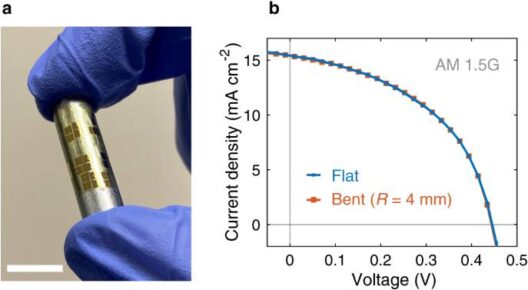
A Photograph of the bending setup. The polyimide substrate is attached to an 8-mm-diameter metal cylinder, causing bending of the substrate at a curvature radius of 4 mm. Scale bar, 1 cm. b Measured J– I characteristics of a typical flexible WSe2 solar cell under AM 1.5 G illumination in flat and bent conditions. Bending does not change the J–V characteristics of the device
Cleantechnica.com explains the structure and amazing thinness of the new material. “The Stanford team was able to produce an active array that is just a few hundred nanometers thick. The array includes the photovoltaic TMD tungsten diselenide and contacts of gold encased in a layer of conducting graphene that is just a single atom thick. All that is sandwiched between a flexible, skin-like polymer and an anti-reflective coating that improves the absorption of light. When fully assembled, the TMD cells themselves are less than six microns thick. It would take 15 layers to reach the thickness of a single piece of paper.”
Tina Casey at Cleantechnica also noted the possibilities of TMD-based solar film if applied to automobiles. She notes the energy pulled in by even a gram of this material. “’The prototype produced 4.4 watts per gram, a figure competitive with other current-day thin-film solar cells, including other experimental prototypes,’ Stanford explains, adding that it ‘realized a 100-times greater power-to-weight ratio of any TMDs yet developed.’
“Apparently you ain’t seen nothing yet, because the researchers calculate that the practical limit of their TMD formula is 46 watts per gram.”
That would produce 4.6 kilowatts per kilogram, but would probably require many square meters of TMD-based cells. Still, the light weight and potentially long life makes the promise of TMDs a tantalizing one.

